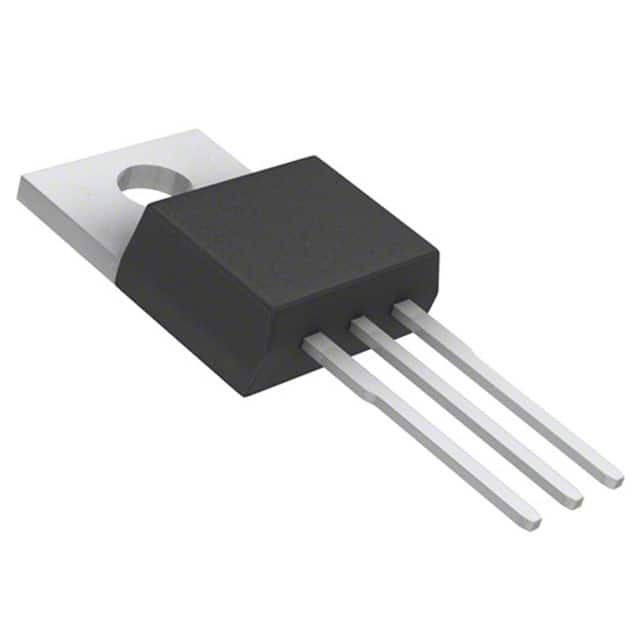FQP10N60C
Introduction
The FQP10N60C is a power MOSFET belonging to the category of electronic components used in various applications. This entry provides an overview of its basic information, specifications, pin configuration, functional features, advantages and disadvantages, working principles, application field plans, and alternative models.
Basic Information Overview
- Category: Power MOSFET
- Use: The FQP10N60C is commonly used in power supply, motor control, and other high voltage applications.
- Characteristics: It exhibits low on-resistance, high switching speed, and low gate charge.
- Package: TO-220
- Essence: The essence of FQP10N60C lies in its ability to efficiently handle high voltage and current levels.
- Packaging/Quantity: Typically packaged in tubes or reels containing multiple units.
Specifications
- Voltage Rating: 600V
- Current Rating: 10A
- On-Resistance: 0.52Ω
- Gate-Source Voltage (Max): ±30V
- Continuous Drain Current (25°C): 10A
- Pulsed Drain Current: 40A
- Operating Temperature Range: -55°C to 150°C
Detailed Pin Configuration
The FQP10N60C typically has three pins: 1. Gate (G) 2. Drain (D) 3. Source (S)
Functional Features
- High voltage capability
- Fast switching speed
- Low on-resistance
- Low gate charge
Advantages and Disadvantages
Advantages
- Efficient handling of high voltage and current
- Fast switching speed
- Low power dissipation
Disadvantages
- Sensitivity to static electricity
- Gate capacitance may affect high-frequency performance
Working Principles
The FQP10N60C operates based on the principle of controlling the flow of current between the drain and source terminals using the voltage applied to the gate terminal. When a sufficient voltage is applied to the gate, it creates an electric field that allows current to flow between the drain and source.
Detailed Application Field Plans
The FQP10N60C finds extensive use in the following applications: - Switching power supplies - Motor control - Inverters - Lighting systems - Audio amplifiers
Detailed and Complete Alternative Models
Some alternative models to FQP10N60C include: - IRFP460: Similar voltage and current ratings - STW20NK50Z: Comparable characteristics and package type - IXFK44N50Q: Alternative with similar specifications
In conclusion, the FQP10N60C power MOSFET offers efficient handling of high voltage and current, making it suitable for diverse applications such as power supplies, motor control, and inverters. While it boasts advantages such as fast switching speed and low power dissipation, it is important to consider its sensitivity to static electricity and potential impact of gate capacitance on high-frequency performance when selecting it for specific designs.
[Word count: 424]
قم بإدراج 10 أسئلة وإجابات شائعة تتعلق بتطبيق FQP10N60C في الحلول التقنية
What is the maximum drain-source voltage for FQP10N60C?
- The maximum drain-source voltage for FQP10N60C is 600V.
What is the continuous drain current rating of FQP10N60C?
- The continuous drain current rating of FQP10N60C is 10A.
Can FQP10N60C be used in high-frequency switching applications?
- Yes, FQP10N60C can be used in high-frequency switching applications due to its fast switching characteristics.
What is the typical on-resistance of FQP10N60C?
- The typical on-resistance of FQP10N60C is 0.65 ohms.
Is FQP10N60C suitable for use in power supplies and inverters?
- Yes, FQP10N60C is suitable for use in power supplies and inverters due to its high voltage and current ratings.
Does FQP10N60C require a heat sink for thermal management?
- It is recommended to use a heat sink with FQP10N60C to ensure proper thermal management, especially in high-power applications.
What is the gate-source threshold voltage of FQP10N60C?
- The gate-source threshold voltage of FQP10N60C typically ranges from 2 to 4V.
Can FQP10N60C be used in automotive electronic systems?
- Yes, FQP10N60C can be used in automotive electronic systems, provided it meets the specific requirements and standards for automotive applications.
What are the typical applications of FQP10N60C in industrial settings?
- FQP10N60C is commonly used in industrial motor control, welding equipment, and power factor correction circuits in industrial settings.
Are there any important considerations for driving FQP10N60C in a circuit?
- It is important to ensure proper gate drive voltage and current levels to fully enhance the performance of FQP10N60C in a circuit. Additionally, attention should be given to minimizing parasitic inductance in the gate drive circuit for optimal switching behavior.


